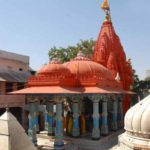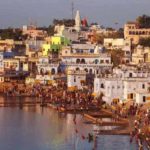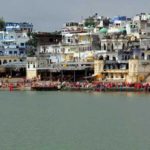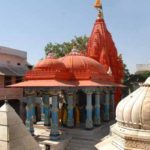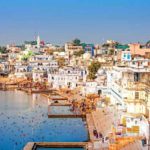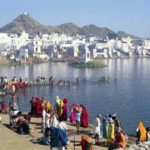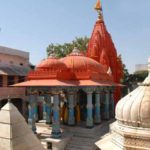Gayatri Mata Temple Pushkar is a hill-top temple dedicated to Goddess Gayatri who is said to be the consort of Brahma. Along with Goddess Gayatri, Lord Brahma and Godess Savitri are worshipped in this temple.
According to Hindu mythology, Lord Brahma dispatched a swan with a lotus in its beak to drop at a place where he would perform a yagna. The place where the swan dropped the lotus was Pushkar and thus it is considered a major pilgrimage spot for Hindus. The prime attraction at this temple is the Rajasthani architecture. Devotees throng the temple to worship and enjoy the scenic views from the hill-top.
You can visit Gayatri Mata Temple from 6 am to 9 pm. If you are travelling by train, then the Gayatri temple will be 11 km away. You can easily reach by bus and private taxis.
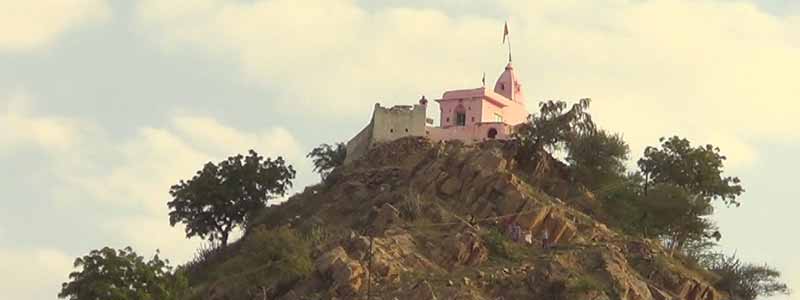
History
Lord Brahma has two consorts namely Savithri and Gayatri Mata Temple. There is a separate shrine for goddess Gayatri at Pushkar but at opposite end of the lake. Goddess Savithri seated on the highest hill in Pushkar, whereas goddess Gayatri, is seated at the eastern side of the Pushkar Lake. Goddess Gayatri temple (locally called as Pap Mochani Mandir) is easy to get in to by 30 minute walk on the steps. It is behind Marwar bus stand at Pushkar town. On the request of Gayathri Lord Bramha granted a boon to her to be head of Vedas with five divine characters.
So she has five faces of different colours as indication of her divine powers and as a presiding deity over the four Vedas, namely the sacred Sanskrit scripts of Hindus. Gayatri blessed Pushkar to be the king of pilgrimages. The idol of Gayathri is very beautiful and attractive. You will be pleased to see her smiling, bewitching, attractive faces. I felt as if Mother goddess Gayathri is sitting like a living Goddess. The Pushkar town bus stand gets number of buses from Ajmer, which is about 11 km from here. The local rail way station brings trains from Ajmer. Ajmer is a railway junction connected to almost all cities in India.
The nearest airport is in Jaipur at distance of 146 km from there one has to take a train, bus or private vehicle to come to Pushkar. One of the major attractions of Pushkar, Gayatri Mata Temple is dedicated to Goddess Gayatri. The Temple is set at the top of a hill by the side of the holy pond. To reach the temple, devotees need to climb a small hill. Goddess Gayatri is worshipped in the temple along with Lord Brahma and Goddess Gayatri Mata Temple.
As per Hindu mythology, Lord Brahma released a swan with a lotus in its beak from the heaven to drop to the place where he would perform a grand yagna. The place was Pushkar and that is why, it is considered a major pilgrimage spot for Hindus. Goddess Gayatri is the consort of Lord Brahma and it is believed that she stood by him while he performed the yagna at Pushkar. However, Goddess Gayatri was an untouchable. According to the legend, it is believed that to purify her she was put into the mouth of a cow and taken out from the other end.
The star attraction of the temple is its wonderful Rajasthani architecture. The architecture of the temple offers an opportunity to know about the culture of Rajasthan to every visitor. The temple holds immense spiritual importance. Because of this importance, a huge number of devotees visit the temple everyday to offer prayers to Goddess Gayatri Mata Temple.
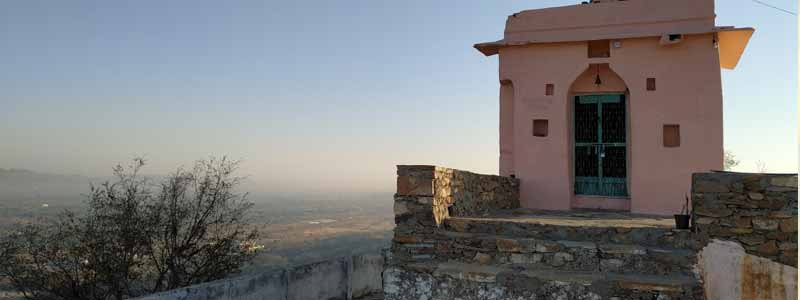
Places to See in Pushkar
Pushkar is not an unknown name, from the religious sights to the quirky cafes; there is an abundance of tourist places in Pushkar with hopeful surprises in every corner. The small shops lined up in the colorful streets are full of joy, vibrancy, culture, and warmth. Puskar is that corner of India where people get stunned by everything they see.
Puskar border the Thar Desert and hence desert safaris are the most common adventure activity that excites the visitors. Pushkar Lake has 52 Ghats and where one can bathe. Jagatpita Brahma Mandir is the only temple dedicated to the Lord of creation (Brahma). The place is definitely not a big town but a rustic village that has gone hippie in the last couple of years.
There are tons of items that you can take back home from the pretty markets of Pushkar like stunning silver jewelry, palazzos, bangles, bandhani sarees, artifacts made of mud and lovely dupattas. People mostly combine Ajmer and Pushkar in one trip due to the proximity they share, however, it is not a bad idea. Take a traditional homestay for your sojourn in Pushkar and you will undoubtedly fall in love with Pushkar, the village that gives an unforgettable experience.
Varaha Temple
According to legend, once upon a time, a demon called Hiranyaksha was going about destroying all life on earth and threatened to finish off the planet. Seeing his destruction, Lord Vishnu appeared in the avatar of half a boar-half man and killed the demon. At different times, when the forces of evil were gathering strength, Lord Vishnu would take on an avatar and appear on earth to defeat these evil forces. According to Hindu mythology, he embraced nine such avatars, one of which was Varaha. This temple is dedicated to the Varaha avatar of Vishnu.
The Varaha temple was built in the 12th century by King Anaji Chauhan. Varaha or the boar is believed to be an incarnation of Lord Vishnu. The temple was partly destroyed by the Mughal emperor Aurangzeb but was renovated again in the 18th century by the Raja Sawai Jai Singh II of Jaipur.
The temple has a huge statue of the Lord Varaha in its inner sanctum which is white in colour. Apart from this, there are many intricate carvings and pillars depicting Garuda and life-sized statues of dwarpalikas or sentries guarding the temple doors.
The best time to visit Varaha temple is during winters which are from October to February. You can visit the temple anytime from sunrise to sunset. Once you reach the railway station or airport, you will easily get buses and taxis to Varaha Temple.
Old Rangji Temple
One of the most popular religious sites in Pushkar, the Old Rangji temple is a 150-year old temple dedicated to Lord Rangji who is an incarnation of Lord Vishnu. Embodying a fine mix of Mughal and Rajput architecture, the temple also has shades of South Indian architecture with its high-rising Gopuram. Old Rangji Temple is dedicated to Lord Ranga.
The temple was commissioned to be built in the year 1823 by a rich merchant Seth Puran Mal Ganeriwal of Hyderabad. The temple houses the idols of Lord Rangji, idols of Lord Krishna, Goddammahi, Goddess Lakshmi and Shri Ramanujacharya.
Almost all the major festivals on the Hindu religious calendar are celebrated here and they draw huge crowds of devotees from across Rajasthan.
Old Rangji Temple is only one km away from the Pushkar bus station. It will take around 30 minutes to completely explore Old Rangji Temple. This temple remains open from 6 am to 7 pm and it is close to Pushkar Lake.
Apteshwar Temple
Apteshwar Temple is one of the religious sites in India, that boast of spellbinding architecture and religious rituals. A temple that endured the ravages of time, this 12th-century structure was destroyed by Aurangzeb but reconstructed again.
The main deity here is the Shiva Lingam that is served with curd, milk, ghee, and honey. Apart from this, devotees also offer ‘bel’ leaves to the Lord, which they believe helps in fulfilling their wishes.
Devotees and tourists from all parts of the world visit this temple to take part in the rituals and admire the architecture. Shivaratri is the main festival here, which is celebrated with great fervour and joy.
The distance between Pushkar Bus Station and Apteshwar Temple is only one km. It is located near the Brahma temple and you can visit this temple from 6.30 am to 8.30 pm. The Apteshwar temple is famous for its architecture, the white marbles and the serene beauty of Shiva make Apteshwar temple a must-visit Gayatri Mata Temple.
Raghunath Temple
Pushkar has two Raghunath temples with the older one being built in 1823 and dedicated to Lord Vishnu. Here, Vishnu is worshipped in the form of Lord Rama who is one of the nine incarnations of Vishnu.
Like other religious sites in the area, this one too has beautiful architecture and has deities of Lord Venugopal, Goddess Lakshmi, and Lord Narsimha.
The newer Raghunath temple has deities of Lord Vaikunthanath and Goddess Lakshmi. This temple has seven other shrines with one shikhara each. Only Indians are allowed to enter this temple.
Raghunath temple remains open from 6 am to 9 PM and the best time to visit this temple will be during winters. During summers, the temperature soars, making it extremely difficult for the visitors to explore the temple wholeheartedly. To completely explore Raghunath temple, it takes somewhere around 1 to 2 hours.
Saraswati Temple
Saraswati Temple is one of the well-regarded religious sites in Pushkar. It is dedicated to Devi Saraswati who is another wife of Brahma. Saraswati is the goddess of knowledge and art. The temple offers a very tranquil environment which is loved by the visitors and pilgrims to the temple. Everyone and almost anyone associated with professions related to art and knowledge definitely pays a visit to the temple.
Goddess Saraswati is considered to be the deity of science, arts, skills, and crafts. The Saraswati Temple celebrates Saraswati Pooja every year and people from all across the city visit this temple to offer their prayers.
Visit Saraswati temple in Pushkar from October to March. This temple remains open from 6 am to 9 pm.
Savitri Temple
The Savitri Temple is another one of the notable and striking religious sites in Pushkar Tour Packages.
According to Hindu mythology, Savitri Devi was the wife of Brahma and she was supposed to reach a yagna which Brahma was performing but she couldn’t reach on time. In order to perform the yagna on time, Brahma married a local girl called Gayatri who then became the second wife of Brahma. All this made Goddess Savitri very angry.
In order to please her, the shrine of Savitri Devi was built. Even today, the evening Arti is first performed in Savitri Temple and then in Gayatri Temple. The deities of both the goddesses are kept in the Savitri Temple.
This hill-top shrine is also thronged by devotees during all the major Hindu festivals across the year.
Brahma Temple
The Brahma Temple is one of the temples in Pushkar that needs no introduction across India. It is the only temple in the world that is dedicated to Lord Brahma. The red spire and the image of the swan (considered sacred to Lord Brahma) are the identifying marks for this temple. The inner sanctum of the temple has the Chaturmukhi (four-faced) idol of Lord Brahma. Apart from this, a marble statue of the Sun God stands guard at the doors of the temple. It is said that the Brahma temple in Pushkar is about 2000 years old Gayatri Mata Temple.
If you want to visit Brahma temple, then the best time is the Ratri Shayan Arati. This temple remains open from 6.30 am to 8.30 pm. Brahma temple is only 10 km away from the Ajmer city and you will easily find buses, taxis, and trains to commute. Brahma temple conducts three aratis on a daily basis, first is the Sandhya arati which happens during the evening around 40 minutes past the sunset, second is the Ratri Shayan Arati which happens after 5 hours of sunset, and in the morning, the Mangalaarati is held Gayatri Mata Temple.
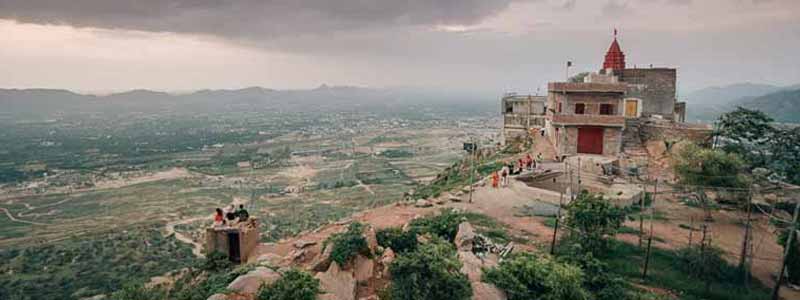
How to reach
Pushkar by Air Sanganer Airport is located in Jaipur which is considered as the nearest airport that further links the town of Pushkar to the other major cities of the country. The airport is located at a distance of almost 146 kilometers from Pushkar. This airport is well equipped with other major cities of the country such as Delhi, Mumbai, Kolkata, Indore, Jodhpur and Udaipur.
Pushkar by railways Ajmer is the nearest railway station which is well linked with Pushkar through a number of taxia and buses. The railway station is located at a distance of almost 11 km. Ajmer itself is well connected with major cities of Rajasthan and then the other cities of whole country as well Gayatri Mata Temple.
Pushkar by road Pushkar is well connected to the major roadways and main national highways of Rajasthan which further connects the town with other major cities of the country. The Marwar bus stand is located in the northern side of Pushkar. This beautiful city is well connected with major cities of the country such as Delhi, Jaipur, Jodhpur and Bikaner, which are situated at a distance of 405 KM, 141 KM, 215 KM and 330 KM respectively.

